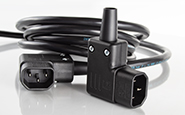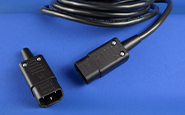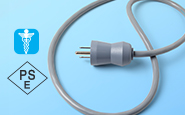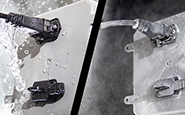More Information on Circuit Breakers
Electronic equipment is often designed with built-in circuit protection. The main function is to provide protection to both the equipment and the equipment operator in the event of a circuit overload.
This protection usually comes in one of two forms: a circuit breaker or a fuse. A circuit breaker is an automatic switch that prohibits the flow of electric current when it is rapidly overloaded or unusually stressed. A fuse is a safety device that protects an electric circuit from excessive current.
In principle, a circuit breaker is like a fuse—it can open the circuit pathway in the event of an overload or short circuit. Unlike the fuse, the circuit breaker is reusable. It is available in a manual or automatic reset. A manual reset requires the user to press a button or move a level to reset the circuit pathway. An automatic reset will return to normal functioning once normal conditions resume.
When the current is larger than the circuit breaker is designed to handle, the switch contacts open, breaking the current. This occurrence is often referred to as being “tripped.” When the issue is resolved (whatever “tripped” the circuit is repaired), the circuit breaker can be reset by a push of a button or a flip of a switch. The contacts will remain closed unless another overcurrent fault condition occurs in the protected circuit, causing it to trip again. Circuit breakers can be designed to trip more rapidly than fuses, although they are typically larger and more costly.
Circuit Protection
Circuit protection covers a wide range of products and applications. It is available for electrical mains, branches, and equipment.
Supplementary Circuit
A circuit breaker is a circuit protection device that falls into the supplementary circuit protection category. It is designed to shut off electrical current, before overcurrent damage can occur in the equipment. The protection is for equipment circuitry, not branch circuitry.
Branch Circuit
Branch circuitry can be found in homes, office buildings, and manufacturing facilities. It consists of circuit breakers and/or fuses at the service panel connected to solid strand conductors running throughout the building. It provides electrical current to the outlets and switches. Its design and function is different from supplementary Circuit breakers.
Characteristics of a Circuit Breaker
- A circuit breaker is reusable and can be reset after it has tripped. While it may take longer for a circuit breaker to trip when exposed to moderate overloads, at high overloads it tends to trip more quickly. When tripped, it provides a clear indication that it has tripped.
- It can eliminate an incorrect fuse replacement because it is reusable. When a fuse is needed, there is the possibility that an incorrectly rated fuse may be used which could result in injury or equipment damage.
- A circuit breaker’s design allows for repeated use. It can be used many times before needing to be replaced. Factors that may affect its life span include arc strength, setting time, and frequency of resetting.
- Ambient temperatures do not affect some types of circuit breakers as much as a supplementary fuse may be affected.
- A circuit breaker can be combined with a switch providing both on/off and circuit protection in one unit.
- A circuit breaker, when compared to a supplementary fuse, is larger in size, so it take up more panel and internal space. It if does become disabled, replacing one may require a technician to replace it.
- The ratings are in larger increments for a circuit breaker. Many are not available with the minute adjustment levels of certain fuses. For example, a fuse can be in milliamps, while a circuit breaker is in even or half increments.
- Initially, a circuit breaker may be more costly than a fuse. The savings can come with the reduction in replacing components.
Purpose of Supplementary Protection
The purpose of supplementary protection is to ensure the safety of the operator and components of the equipment from overcurrent or short circuit faults that cannot be adequately cleared by the branch protection. The components include cable assemblies, inlets, and circuit board components. An example is a cable assembly bringing power into the equipment. If an overcurrent is sufficient in power and duration, it could cause the power cord to melt and/or catch fire. Continued overcurrents can weaken conductor strands and electrical connections, causing an improper pathway.
Short circuits can be six times the normal electrical current. A short circuit is an alternative pathway for the electrical current to flow. This pathway can be the chassis of the equipment on which users have occasional contact. Contact with equipment chassis containing a short circuit current can be very dangerous.
Protection of inlets and outlets is important to the equipment. A cord set not properly connected to an inlet or outlet can cause an increase in resistance. This change in the current poses a risk to the internal components.
Other components that need protection are connected to the circuitry of the equipment. These components may operate at lower levels of electrical current than what enters the equipment. Any overcurrent can cause severe costly damage to the equipment meaning expensive repairs or purchase of new equipment.
During a short circuit, the current is redirected from the normal pathway to an alternate pathway. This pathway is most often the chassis of the equipment. A user making contact with the equipment becomes part of the electrical pathway. The supplementary protection device senses this and is activated, protecting the user from danger. Preventing these occurrences is the purpose of the supplementary circuit protection devices.
Circuit breakers only protect against low-level faults and are not meant to clear faults with high-voltage levels. A circuit breaker is not a surge resistor for catastrophic events, such as lightning strikes or high-voltage line shorts.
Application
Location Requirements
Location of the supplementary protection device is important. Ambient temperature affects the operation of the supplementary device. The impact is especially true on thermal devices. Warmer temperatures can cause it to open prematurely. Cold temperatures can cause it to have a delayed response.
The ease of changing or resetting the supplementary protection device is important and needs to be considered in the selection process. Placement in the most accessible location is ideal, but closeness to the power as it enters the equipment can be a concern. Having to pull out the equipment when the protection device fails is not convenient.
Performance Requirements
The performance capability of a supplementary circuit protection device determines its use. Fuses can be fast-acting or time-delayed. Selection depends on the need within the equipment. While circuit breakers can do the same thing, they are not as sensitive in the interruption capacity.
Connections
The terminations used on the CBEs come with a combination terminal that will accept soldering or a 6.3mm QD. The choice of method is left up to the customer. These are the kind of CBE terminations offered by Interpower—there are other versions available by other companies.






